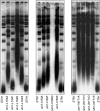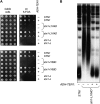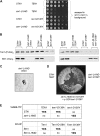Structure prediction-driven genetics in Saccharomyces cerevisiae identifies an interface between the t-RPA proteins Stn1 and Ten1
- PMID: 20157006
- PMCID: PMC2870947
- DOI: 10.1534/genetics.109.111922
Structure prediction-driven genetics in Saccharomyces cerevisiae identifies an interface between the t-RPA proteins Stn1 and Ten1
Abstract
In Saccharomyces cerevisiae, Cdc13, Stn1, and Ten1 are essential for both chromosome capping and telomere length homeostasis. These three proteins have been proposed to perform their roles at chromosome termini as a telomere-dedicated t-RPA complex, on the basis of several parallels with the conventional RPA complex. In this study, we have used several approaches to test whether a predicted alpha-helix in the N-terminal domain of the S. cerevisiae Stn1 protein is required for formation of the proposed t-RPA complex, in a manner analogous to the comparable helix in Rpa2. Analysis of a panel of Rpa2-OB(Stn1) chimeras indicates that whether a chimeric protein contains the Rpa2 or Stn1 version of this alpha-helix dictates its ability to function in place of Rpa2 or Stn1, respectively. In addition, mutations introduced into a hydrophobic surface of the predicted Stn1 alpha-helix eliminated association with Ten1. Strikingly, allele-specific suppression of a stn1 mutation in this helix (stn1-L164D) by a ten1 mutation (ten1-D138Y) resulted in a restored Stn1-Ten1 interaction, supporting the identification of a Stn1-Ten1 interface. We conclude that Stn1 interacts with Ten1 through an alpha-helix, in a manner analogous to the interaction between the comparable subunits of the RPA complex.
Figures






References
-
- Bianchi, A., S. Negrini and D. Shore, 2004. Delivery of yeast telomerase to a DNA break depends on the recruitment functions of Cdc13 and Est1. Mol. Cell 16 139–146. - PubMed
MeSH terms
Substances
Grants and funding
LinkOut - more resources
Full Text Sources
Molecular Biology Databases
Miscellaneous

